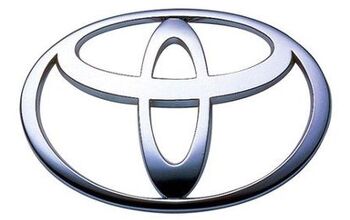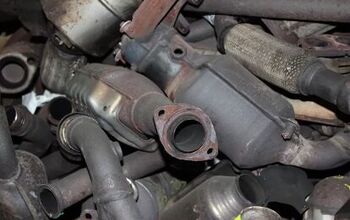Review: Toyota Under Fire
Has it really been a year since the United States tore itself apart in a frenzy over the possibility that Toyota’s might suddenly accelerate out of control? So intense was the furor over Toyota’s alleged misdeeds, that it seems like the whole scandal occurred only yesterday, yet the brevity of the crisis already gives it the distance of ancient history. Now, just a year after the height of the hysteria, the first major book on the subject has arrived, casting a clear light on the events of the recall. Serving as a history of the scandal, a case study in Toyota’s responses to it, and a cutting critique of the media’s coverage of the recall, Toyota Under Fire is a powerful reminder of the many lessons that emerged from one of the most intense and unexpected automotive industry events in recent years.
One of the inevitable challenges facing anyone writing about the Toyota Recall Scandal is placing a starting point on the narrative. Some have suggested that long-term erosions of quality control led, inexorably, over the years to the cries. Others claim that Toyota’s rapid expansion in the late 1990s and early 2000’s sowed the seeds of its embarrassment. Though elements of these theories seem to have played some role in the events of the recall, the authors of Toyota Under Fire, Jeffery K. Liker, an engineering professor at the University of Michigan, and Timothy Ogden of Sona Partners, begin by charting Toyota’s rise and then launch their narrative in earnest at the outset of the oil crisis and recession of 2008. By combining the recession (which led to the bankruptcy-bailouts of two of Toyota’s key US-based competitors) and the recall scandal, Liker and Ogden are able to paint a compelling portrait of a firm facing two very different problems.
This approach works perfectly for Toyota Under Fire, as Liker and Ogden are students of Toyota’s corporate culture and philosophy, and are able to show how Toyota applied its values to solving two very different problems. In fact, though Toyota Under Fire is the best history of the recall scandal written to date, Liker insists in his preface that
There is a great deal of detail from our investigations and interviews that doesn’t appear in this book, because this book is not intended to be a defense of Toyota or investigative journalism. Instead we’ve tried to provide the materials that are relevant to understanding the crisis and what others can learn from it. The hard times Toyota was living through allowed us to see Toyota in a different context than ever before.
This new context is the crux of the book, and Liker’s background as a decades-long student of Toyota’s corporate philosophy and previous authorship of The Toyota Way, which explores this topic, is germane. As Liker says, he is not an investigative journalist bound to the ideal of pure objectivity, but a long-term student and (admitted) admirer of Toyota’s ideas and practices. This familiarity with, and respect for, Toyota’s values meant that, when the crisis hit,
the press reports were painting a picture of a company that looked nothing like the one I know.
And though he admits that “my first instinct was to write a storm of letters to the editor and opinion columns defending Toyota,” he reveals that a friend and fellow Toyota Way acolyte reminded him that such a defense would not be in accordance with genchi gunbutsu (go and see), a key Toyota value. Instead, he and Ogden applied Toyota values like genchi gunbutsu to a thorough investigation of the recall, a process that produced Toyota Under Fire. And the key finding of their research is that, faced by both a “carpocalyptic” recession and a major recall scandal, Toyota did precisely the same thing, turning to the corporate values that launched it to the pinnacle of industrial achievement, and rigorously applying them to a variety of challenges. Both Toyota’s emergence from the twin crises and the high-quality research and analysis of Toyota Under Fire stand in tribute to these values.
Corporate mission statements may not be the reason most of us read about cars, but any student of the industry (and business leaders in any industry) will find much to learn from Toyota Under Fire’s culture-centric analysis of Toyota’s actions since 2008. For example, Toyota’s decision not to involuntarily separate its US manufacturing staff even when the recession caused massive overcapacity could be read as misguided altruism or a neo-“Jobs Bank” aimed simply at keeping workers happy, but as the authors point out, the issue is actually that Toyota sees employees as investments which become more valuable as they learn and apply Toyota’s values. This might sound like so much feel-good propaganda, but Liker and Ogden bring a wealth of evidence connecting Toyota’s values and practices with the exercises, trainings, “quality circles” and waste-eliminating efforts, and connecting these to tangible results in Toyota’s US plants. Though a large cash pile helped, Liker and Ogden point out again and again that Toyota’s profound commitment to the practical application of values like “embrace challenge,” kaizen (continuous improvement), and “customer first” allows it to emerge from challenge after challenge, stronger than before.
Having endured the recession with relatively minor losses, Toyota was poised to resume its ruthless domination of the auto industry (particularly in the US market), when the recall scandal struck in earnest in the fall of 2009, with the infamous crash of an off-duty police officer near San Diego. Here Liker and Ogden switch to a more investigative mode, focusing on the facts of each incident and recall, as well as the media’s coverage and the government’s response. TTAC readers will be familiar with the extent to which hysteria around sudden acceleration in Toyotas was fueled by ignorance, media hype and government posturing, but readers who did not seek out solid reporting on the subject or who still do not understand the issues will have their eyes opened [see also TTAC’s retrospective on the recall]. Without belaboring the point, Liker and Ogden’s thorough survey of the recall’s timeline is critical of NHTSA, but damning of the news media and the trial lawyers who so masterfully manipulated it. And more than merely debunking the witch-hunt hype, Toyota Under Fire goes a step further, exploring some of the intriguing characteristics that make electronics systems and sudden unintended acceleration so vulnerable to such hysteria.
But perhaps the most fascinating chapter in Toyota Under Fire deals with Toyota’s response to the crisis, in which Liker and Ogden’s familiarity with the Toyota culture, not to mention their deep access to company figures and facilities, once again serves them well. In light of the dispassionate dissection of the media-fueled recall scandal, which serves well to put the accusations against Toyota into some much-needed context, it’s not surprising that the chapter opens with a chronological description of Toyota’s responses to the different stages of the scandal, starting with Toyota’s efforts to react to, and contain the situation. Though Toyota’s efforts to mobilize dealers and customer service call centers to deal with the problem, as well as its (somewhat belated) efforts to address widespread misperceptions are good illustrations of the company’s strategy, it isn’t until phase three “turning the crisis into an opportunity” that you really understand the point that Toyota Under Fire is trying to make.
In this section the authors begin drilling down into the root causes for the recall scandal, not simply because it’s the appropriate point in the book’s structure, but because it was at this point that Toyota’s value system forced the firm to do so itself. The authors note
Improvement kaizen and turning the crisis into an opportunity for the company to improve are dependent on correctly identifying the real problems, not just the problems presumed by outside observers. Only then can the underlying root causes of those problems be diagnosed, a necessary step before generating solutions.
The problem as identified by outsiders was, in the words of Ray LaHood, that Toyota had become “safety deaf.” Liker and Ogden explore that possibility, but argue that neither Toyota’s culture and operations nor a survey of defect and recall data show evidence of that popularly-held perception. Rather, Toyota’s internal investigations and ongoing kaizen processes pointed to a number of factors which allowed the scandal to play out. Toyota’s organizational structure, with sales split from manufacturing and overseas operations split from corporate headquarters was identified as an underlying weakness, hurting Toyota’s ability to communicate with government regulators (for example, after-sales engineering was based in Japan, unable to communicate with local regulators). Toyota’s methodical pace was acknowledged as a problem, as it fed media speculation. Another problem, possibly one of the most serious, was Toyota’s weakness in listening to customers. Shinichi Sasaki, Executive VP for global quality explains:
As you know, Toyota has made a lot of efforts to achieve the classical definition of quality control… things like the dependability and durability of the vehicles. But, if there’s a lesson from the recent recalls, it’s that things we engineers do not think are serious could sometimes create a lot of concerns on the part of the customers… We should not just be talking to the customers from a purely engineering viewpoint, but we have to care more about the customer’s feelings.
This, in a nutshell, seems to be the major area where Toyota contributed to its misfortune in the recall crisis. Not only does SUA bend the traditional “defect” paradigm, but in my opinion Toyota’s core value of not blaming customers may have denied it an important tool in explaining the distinction between a true “defect” and an opportunity to misuse or become frightened by an automobile (like installing the wrong mats, or misunderstanding the function of a “smart” cruise control system). From a pure PR perspective, one could argue that Toyota allowed its reputation to be turned on its head (at least temporarily) in order to avoid the perception that it was blaming anyone other than itself, an approach that actually fueled suspicion of it.
But, as Toyota Under Fire proves, culture is the lifeblood of Toyota, and blaming customers would have gone against a number of the firm’s cultural values, including “customer first” and “ownership and responsibility.” Though adhering to that culture put Toyota at a tactical disadvantage once in the midst of the scandal, the fact that Toyota refused to abandon its principles in a moment of desperation will ultimately maintain the firm’s strategic advantage. Had Toyota truly become “safety deaf” or actually allowed dangerous defects to be sold, it might have had some cause to rethink the culture that has launched it to the top of the auto industry. Because the recall scandal was actually caused by a number of subtle, even mundane challenges that arose from Toyota’s development, the Toyota Way (which is, at its base, a system of identifying and eliminating problems) was the perfect foundation on which to once again rebuild the company.
Toyota Under Fire ends with a number of lessons, aimed largely at leaders of organizations wishing to learn from Toyota’s experience. The authors offer lessons about cross-cultural communication, the media, confronting weaknesses, taking responsibility and more, but perhaps the most important lesson is the simplest one: commitment to a healthy culture will always trump radical change once a crisis arrives. In an industry dominated by products, personality, style and cyclical changes, it’s easy to forget that one of Toyota’s greatest contributions to modern industry is in its corporate culture.
In fact, since Toyota’s struggles last year, several industry commentators have goner as far as to wonder how Toyota ever became as dominant as it did, given that its brand and products don’t have any “special appeal” in terms of power, styling or image. What Toyota Under Fire explains so wonderfully is just how deeply engrained Toyota’s culture is in everything it does, how that culture discretely goes about the business of constant improvement, and how it delivers meaningful results even when facing huge challenges. And as Toyota has proved by becoming one of the world’s dominant automakers and then surviving two huge challenges in its largest market, the cultural “intangibles” can be the difference between success and failure.
Toyota Under Fire is available from Amazon and other fine book retailers. Contact the authors, access their research materials and order the book directly at www.toyotaunderfire.com
The Truth About Cars, Edward Niedermeyer and Bertel Schmitt are all cited as sources in this book.
More by Edward Niedermeyer
Latest Car Reviews
Read moreLatest Product Reviews
Read moreRecent Comments
- TheEndlessEnigma I would mandate the elimination of all autonomous driving tech in automobiles. And specifically for GM....sorry....gm....I would mandate On Star be offered as an option only.Not quite the question you asked but.....you asked.
- MaintenanceCosts There's not a lot of meat to this (or to an argument in the opposite direction) without some data comparing the respective frequency of "good" activations that prevent a collision and false alarms. The studies I see show between 25% and 40% reduction in rear-end crashes where AEB is installed, so we have one side of that equation, but there doesn't seem to be much if any data out there on the frequency of false activations, especially false activations that cause a collision.
- Zerocred Automatic emergency braking scared the hell out of me. I was coming up on a line of stopped cars that the Jeep (Grand Cherokee) thought was too fast and it blared out an incredibly loud warbling sound while applying the brakes. I had the car under control and wasn’t in danger of hitting anything. It was one of those ‘wtf just happened’ moments.I like adaptive cruise control, the backup camera and the warning about approaching emergency vehicles. I’m ambivalent about rear cross traffic alert and all the different tones if it thinks I’m too close to anything. I turned off lane keep assist, auto start-stop, emergency backup stop. The Jeep also has automatic parking (parallel and back in), which I’ve never used.
- MaintenanceCosts Mandatory speed limiters.Flame away - I'm well aware this is the most unpopular opinion on the internet - but the overwhelming majority of the driving population has not proven itself even close to capable of managing unlimited vehicles, and it's time to start dealing with it.Three important mitigations have to be in place:(1) They give 10 mph grace on non-limited-access roads and 15-20 on limited-access roads. The goal is not exact compliance but stopping extreme speeding.(2) They work entirely locally, except for downloading speed limit data for large map segments (too large to identify with any precision where the driver is). Neither location nor speed data is ever uploaded.(3) They don't enforce on private property, only on public roadways. Race your track cars to your heart's content.
- GIJOOOE Anyone who thinks that sleazbag used car dealers no longer exist in America has obviously never been in the military. Doesn’t matter what branch nor assigned duty station, just drive within a few miles of a military base and you’ll see more sleazbags selling used cars than you can imagine. So glad I never fell for their scams, but there are literally tens of thousands of soldiers/sailors/Marines/airmen who have been sold a pos car on a 25% interest rate.

































Comments
Join the conversation
NASA's Michael Kirsch reviewed their results in a summary – 03/11 http://onlinepubs.trb.org/onlinepubs/UA/030311Kirsch.pdf Last page shows that they found errors giving smaller than full throttle openings - couldn't find the cause of "large unintended accelerations". Those smaller ones could explain many of the low crash incidents in parking lots etc. There is no reason why drivers are misapplying pedals in Toyotas, but not in many others such as GM's that have had very very low numbers of cases per vehicle sold. I would bet there still is an electronics /computer error. There have been too many cases such as documented in: http://articles.latimes.com/2010/feb/28/business/la-fiw-toyota-deaths-list28-2010feb28 Toyota has many fewer complaints now - still more than others - see: http://blogs.consumerreports.org/cars/2011/02/special-report-toyota-acceleration-complaints-drop-following-recalls.html and were much worse before the Saylor incident and recalls http://blogs.consumerreports.org/cars/2009/12/sudden-unintended-acceleration-sua-analysis-2008-toyota-lexus-ford-gm.html
Did you separate out cruise control issues for Fords and crappy wiring for Volvos? Are you calling NASA's lead guru Michael Kirsch a liar? From http://onlinepubs.trb.org/onlinepubs/UA/030311Kirsch.pdf NASA detailed analysis and testing did not find evidence that malfunctions in electronic throttle control caused large unintended accelerations, as described by some consumer reports. NASA found a way that the electronic throttle control can fail, that combined with driver input, can cause the throttle to jump to 15 degrees open, but consumer reports of this condition is very low and it leaves evidence of occurrence. NASA found ways that the electronic throttle control can fail that results in small throttle openings up to 5 degrees. Hope there is no way Toyota could have changed the code. Maybe NASA didn't download the code from an actual model from one of the models with highest incidents per vehicle sold. NASA/NESC analyzed SOME of the code - appears to have used a good checker - but may not have been the source code: http://www.grammatech.com/news/2011/releases/02-14-11.html Wonder if it is as good or better than MISRA http://www.oregonsae.org/Meetings/misra_C.pps There are a couple million lines of code and I still believe NASA just didn't find the gremlin for as they called "large unintended accelerations". Perhaps the 10 investigators that will have the secret source code in the big CA trial will.